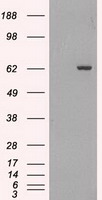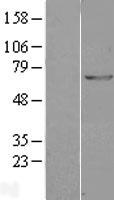GAD67 (GAD1) (NM_000817) Human Tagged ORF Clone
CAT#: RC207226
- TrueORF®
GAD1 (Myc-DDK-tagged)-Human glutamate decarboxylase 1 (brain, 67kDa) (GAD1), transcript variant GAD67
ORF Plasmid: tGFP
"NM_000817" in other vectors (6)
Need custom modification / cloning service?
Get a free quote
CNY 6,632.00
| Cited in 2 publications. |
CNY 300.00
CNY 1,999.00
CNY 2,700.00
Specifications
| Product Data | |
| Type | Human Tagged ORF Clone |
| Tag | Myc-DDK |
| Synonyms | CPSQ1; DEE89; GAD; SCP |
| Vector | pCMV6-Entry |
| E. coli Selection | Kanamycin (25 ug/mL) |
| Mammalian Cell Selection | Neomycin |
| Sequence Data |
>RC207226 ORF sequence
Red=Cloning site Blue=ORF Green=Tags(s) TTTTGTAATACGACTCACTATAGGGCGGCCGGGAATTCGTCGACTGGATCCGGTACCGAGGAGATCTGCC GCCGCGATCGCC ATGGCGTCTTCGACCCCATCTTCGTCCGCAACCTCCTCGAACGCGGGAGCGGACCCCAATACCACTAACC TGCGCCCCACAACGTACGATACCTGGTGCGGCGTGGCCCATGGATGCACCAGAAAACTGGGGCTCAAGAT CTGCGGCTTCTTGCAAAGGACCAACAGCCTGGAAGAGAAGAGTCGCCTTGTGAGTGCCTTCAAGGAGAGG CAATCCTCCAAGAACCTGCTTTCCTGTGAAAACAGCGACCGGGATGCCCGCTTCCGGCGCACAGAGACTG ACTTCTCTAATCTGTTTGCTAGAGATCTGCTTCCGGCTAAGAACGGTGAGGAGCAAACCGTGCAATTCCT CCTGGAAGTGGTGGACATACTCCTCAACTATGTCCGCAAGACATTTGATCGCTCCACCAAGGTGCTGGAC TTTCATCACCCACACCAGTTGCTGGAAGGCATGGAGGGCTTCAACTTGGAGCTCTCTGACCACCCCGAGT CCCTGGAGCAGATCCTGGTTGACTGCAGAGACACCTTGAAGTATGGGGTTCGCACAGGTCATCCTCGATT TTTCAACCAGCTCTCCACTGGATTGGATATTATTGGCCTAGCTGGAGAATGGCTGACATCAACGGCCAAT ACCAACATGTTTACATATGAAATTGCACCAGTGTTTGTCCTCATGGAACAAATAACACTTAAGAAGATGA GAGAGATAGTTGGATGGTCAAGTAAAGATGGTGATGGGATATTTTCTCCTGGGGGCGCCATATCCAACAT GTACAGCATCATGGCTGCTCGCTACAAGTACTTCCCGGAAGTTAAGACAAAGGGCATGGCGGCTGTGCCT AAACTGGTCCTCTTCACCTCAGAACAGAGTCGCTATTCCATAAAGAAAGCTGGGGCTGCACTTGGCTTTG GAACTGACAATGTGATTTTGATAAAGTGCAATGAAAGGGGGGAAATAATTCCAGCTGATTTTGAGGCAAA AATTCTTGAAGCCAAACAGAAGGGATATGTTCCCTTTTATGTCAATGCAACTGCTGGCACGACTGTTTAT GGAGCTTTTGATCCGATACAAGAGATTGCAGATATATGTGAGAAATATAACCTTTGGTTGCATGTCGATG CTGCCTGGGGAGGTGGGCTGCTCATGTCCAGGAAGCACCGCCATAAACTCAACGGCATAGAAAGGGCCAA CTCAGTCACCTGGAACCCTCACAAGATGATGGGCGTGCTGTTGCAGTGCTCTGCCATTCTCGTCAAGGAA AAGGGTATACTCCAAGGATGCAACCAGATGTGTGCAGGATACCTCTTCCAGCCAGACAAGCAGTATGATG TCTCCTACGACACCGGGGACAAGGCAATTCAGTGTGGCCGCCACGTGGATATCTTCAAGTTCTGGCTGAT GTGGAAAGCAAAGGGCACAGTGGGATTTGAAAACCAGATCAACAAATGCCTGGAACTGGCTGAATACCTC TATGCCAAGATTAAAAACAGAGAAGAATTTGAGATGGTTTTCAATGGCGAGCCTGAGCACACAAACGTCT GTTTTTGGTATATTCCACAAAGCCTCAGGGGTGTGCCAGACAGCCCTCAACGACGGGAAAAGCTACACAA GGTGGCTCCAAAAATCAAAGCCCTGATGATGGAGTCAGGTACGACCATGGTTGGCTACCAGCCCCAAGGG GACAAGGCCAACTTCTTCCGGATGGTCATCTCCAACCCAGCCGCTACCCAGTCTGACATTGACTTCCTCA TTGAGGAGATAGAAAGACTGGGCCAGGATCTG ACGCGTACGCGGCCGCTCGAGCAGAAACTCATCTCAGAAGAGGATCTGGCAGCAAATGATATCCTGGATT ACAAGGATGACGACGATAAGGTTTAA >RC207226 protein sequence
Red=Cloning site Green=Tags(s) MASSTPSSSATSSNAGADPNTTNLRPTTYDTWCGVAHGCTRKLGLKICGFLQRTNSLEEKSRLVSAFKER QSSKNLLSCENSDRDARFRRTETDFSNLFARDLLPAKNGEEQTVQFLLEVVDILLNYVRKTFDRSTKVLD FHHPHQLLEGMEGFNLELSDHPESLEQILVDCRDTLKYGVRTGHPRFFNQLSTGLDIIGLAGEWLTSTAN TNMFTYEIAPVFVLMEQITLKKMREIVGWSSKDGDGIFSPGGAISNMYSIMAARYKYFPEVKTKGMAAVP KLVLFTSEQSRYSIKKAGAALGFGTDNVILIKCNERGEIIPADFEAKILEAKQKGYVPFYVNATAGTTVY GAFDPIQEIADICEKYNLWLHVDAAWGGGLLMSRKHRHKLNGIERANSVTWNPHKMMGVLLQCSAILVKE KGILQGCNQMCAGYLFQPDKQYDVSYDTGDKAIQCGRHVDIFKFWLMWKAKGTVGFENQINKCLELAEYL YAKIKNREEFEMVFNGEPEHTNVCFWYIPQSLRGVPDSPQRREKLHKVAPKIKALMMESGTTMVGYQPQG DKANFFRMVISNPAATQSDIDFLIEEIERLGQDL TRTRPLEQKLISEEDLAANDILDYKDDDDKV |
| Chromatograms |
CHROMATOGRAMS
 Sequencher program is needed, download here. |
| Restriction Sites |
SgfI-MluI
Cloning Scheme for this gene
Plasmid Map

|
| ACCN | NM_000817 |
| ORF Size | 1782 bp |
| OTI Disclaimer | Due to the inherent nature of this plasmid, standard methods to replicate additional amounts of DNA in E. coli are highly likely to result in mutations and/or rearrangements. Therefore, OriGene does not guarantee the capability to replicate this plasmid DNA. Additional amounts of DNA can be purchased from OriGene with batch-specific, full-sequence verification at a reduced cost. Please contact our customer care team at custsupport@origene.com or by calling 301.340.3188 option 3 for pricing and delivery. The molecular sequence of this clone aligns with the gene accession number as a point of reference only. However, individual transcript sequences of the same gene can differ through naturally occurring variations (e.g. polymorphisms), each with its own valid existence. This clone is substantially in agreement with the reference, but a complete review of all prevailing variants is recommended prior to use. More info |
| OTI Annotation | This clone was engineered to express the complete ORF with an expression tag. Expression varies depending on the nature of the gene. |
| Product Components | The ORF clone is ion-exchange column purified and shipped in a 2D barcoded Matrix tube containing 10ug of transfection-ready, dried plasmid DNA (reconstitute with 100 ul of water). |
| Reconstitution | 1. Centrifuge at 5,000xg for 5min. 2. Carefully open the tube and add 100ul of sterile water to dissolve the DNA. 3. Close the tube and incubate for 10 minutes at room temperature. 4. Briefly vortex the tube and then do a quick spin (less than 5000xg) to concentrate the liquid at the bottom. 5. Store the suspended plasmid at -20°C. The DNA is stable for at least one year from date of shipping when stored at -20°C. |
| Note | Plasmids are not sterile. For experiments where strict sterility is required, filtration with 0.22um filter is required. |
| Reference Data | |
| RefSeq | NM_000817.3 |
| RefSeq Size | 3488 bp |
| RefSeq ORF | 1785 bp |
| Locus ID | 2571 |
| UniProt ID | Q99259 |
| Domains | pyridoxal_deC |
| Protein Families | Druggable Genome |
| Protein Pathways | Alanine, aspartate and glutamate metabolism, beta-Alanine metabolism, Butanoate metabolism, Metabolic pathways, Taurine and hypotaurine metabolism, Type I diabetes mellitus |
| MW | 66.9 kDa |
| Gene Summary | This gene encodes one of several forms of glutamic acid decarboxylase, identified as a major autoantigen in insulin-dependent diabetes. The enzyme encoded is responsible for catalyzing the production of gamma-aminobutyric acid from L-glutamic acid. A pathogenic role for this enzyme has been identified in the human pancreas since it has been identified as an autoantigen and an autoreactive T cell target in insulin-dependent diabetes. This gene may also play a role in the stiff man syndrome. Deficiency in this enzyme has been shown to lead to pyridoxine dependency with seizures. Alternative splicing of this gene results in two products, the predominant 67-kD form and a less-frequent 25-kD form. [provided by RefSeq, Jul 2008] |
Citations (2)
| The use of this cDNA Clones has been cited in the following citations: |
|---|
|
Abundant glutamic acid decarboxylase (GAD)-reactive B cells in gad-antibody-associated neurological disorders
,Thaler, FS;Thaller, AL;Biljecki, M;Schuh, E;Winklmeier, S;Mahler, CF;Gerhards, R;Völk, S;Schnorfeil, F;Subklewe, M;Hohlfeld, R;Kümpfel, T;Meinl, E;,
Ann. Neurol.
,PubMed ID 30635933
[GAD67]
|
|
Cerebellar Ataxia and Glutamic Acid Decarboxylase Antibodies: Immunologic Profile and Long-term Effect of Immunotherapy
,Ariño, H;Gresa-Arribas, N;Blanco, Y;Martínez-Hernández, E;Sabater, L;Petit-Pedrol, M;Rouco, I;Bataller, L;Dalmau, JO;Saiz, A;Graus, F;,
JAMA Neurol
,PubMed ID 24934144
[GAD67]
|
Documents
| Product Manuals |
| FAQs |
| SDS |
Resources
Other Versions
| SKU | Description | Size | Price |
|---|---|---|---|
| RC207226L1 | Lenti ORF clone of Human glutamate decarboxylase 1 (brain, 67kDa) (GAD1), transcript variant GAD67, Myc-DDK-tagged |
CNY 9,032.00 |
|
| RC207226L2 | Lenti ORF clone of Human glutamate decarboxylase 1 (brain, 67kDa) (GAD1), transcript variant GAD67, mGFP tagged |
CNY 5,890.00 |
|
| RC207226L3 | Lenti ORF clone of Human glutamate decarboxylase 1 (brain, 67kDa) (GAD1), transcript variant GAD67, Myc-DDK-tagged |
CNY 5,890.00 |
|
| RC207226L4 | Lenti ORF clone of Human glutamate decarboxylase 1 (brain, 67kDa) (GAD1), transcript variant GAD67, mGFP tagged |
CNY 5,890.00 |
|
| RG207226 | GAD1 (tGFP-tagged) - Human glutamate decarboxylase 1 (brain, 67kDa) (GAD1), transcript variant GAD67 |
CNY 8,232.00 |
|
| SC119631 | GAD1 (untagged)-Human glutamate decarboxylase 1 (brain, 67kDa) (GAD1), transcript variant GAD67 |
CNY 6,648.00 |


 United States
United States
 Germany
Germany
 Japan
Japan
 United Kingdom
United Kingdom
 China
China




